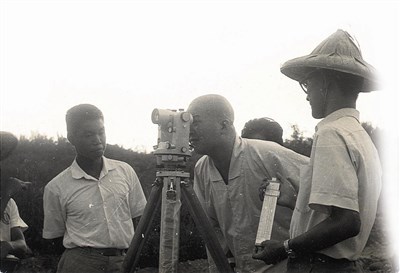The Founding of Fo Guang Shan
By Venerable Master Hsing Yun, 2015




On the day of Fo Guang Shan’s (FGS) Foundation Laying Ceremony, May 16th, 1967, someone asked, “Master, why this place for a temple? Even ghosts won’t want to come here.” I replied, “It doesn’t matter if ghosts don’t come; it’s fine as long as Buddhas
do!”
Someone else said, “This is where even birds avoid; how can human beings live here?” I replied, “Isn’t the Western Pure Land of Ultimate Bliss filled with chirping birds and virtuous people?”
Someone
else said, “How will we survive in this barren valley without water? I replied, “Isn’t the Western Spring still flowing today? Now that we are here, the river of the Dharma will flow for even longer.”
Someone then said,
“With such limited transportation, even if there was a temple, no one would come.” I replied, “This may become the center of Greater Kaohsiung over time.” Everybody then asked, “So what should we name this mountain?” I replied,
“Since it is in Taiwan, let us call it Buddha’s Light Mountain (Fo Guang Shan).” Fo Guang Shan was thus founded.
From then on, bulldozers traveled back and forth to fill up valleys and gutters with soil. Drilling machines
continued to dig and flatten the land. Trucks shifted bricks and tiles, concrete mixers went from the Eastern Hill to the Western Hill, on and off the mountain. The Eastern Buddhist College (1968) building was completed, so was
Fo Guang Senior Citizen’s Home (1976) in the West. The Great Compassion Shrine (1971) and Great Wisdom Shrine (1975) face each other from afar, spreading compassion and wisdom. The Ksitigarbha Shrine (1983) and Samantabadhra Shrine
(1985) one on the lower hill, the other on the higher, and the Shrines of the Four Bodhisattvas, are like the Four Great Mountains. Maitreya Buddha (1971) at the mountain gate, remained unmovable even with several cranes; Ksitigarbha
Bodhisattva from another temple, refused to move on once past the gate, we had no choice but to make him stay. Hundreds and thousands of devotees thus gained strength in faith from him.
The wall of the Life Releasing Pond
was washed away by a flood once, twice, thrice… Regardless of how many times it happened, students of the Buddhist College rebuilt it after each collapse. Finally, it was completed. The Eastern Hill collapsed, the soil of the Western
Hill was washed away, volunteers and workers, one day after another, and yet another, took part in the restoration.
In order to present a versatile monastery, The Non-Duality Gate (1971) stands high and spirited atop the
five hills, the sun rises from the Eastern Hill and sets behind the Western Hill. What had risen, had never rose, what had set, had never set. This is the non-duality of life and death. The is the non-duality of East and West.
This is the non-duality of principle and phenomenon. This is the non-duality of practice and theory!
There were deep valleys in the East, and there was low-lying ground in the West. What are we going to do with valleys
and trenches? This isn’t hell, this isn’t Yama, this is a Dharma world, this is the Pure Land of Ultimate Bliss (1981) as described in the Amitabha Sutra!
At the Vulture Peak (1971), pilgrims flood in like carp. At the
Mountain Gate (1971), a reminder says, “Upon a question asked, ‘where are you headed now?’ Do think thrice about when your next return will be.” We hope everyone can “turn around to find the shore.”
The Buddhist College
building was completed. The “Ocean’s water” (1968) on the hill top now provides water for irrigation. Neighboring farmers tell us, “Rain will fall on our ground, roads will cut through our land. It is tough for us.” Due to this,
purchasing lands required arduous effort in terms of money.
Thanks to the publication of National Master Yulin, the royalties allowed the purchase of FGS lands. Thanks to Guanyin Bodhisattva, whose infinite manifestations
helped build the Great Compassion Shrine. Atop the dragon’s head on the Eastern Hill stands the majestic Welcoming Buddha (1975). At the inaugural ceremony, I said,
With sandstones from Gaoping River,
Water from the
Western Spring,
manpower from the whole of Taiwan,
the tallest Buddha is thus built.
The respectable Great Buddha often reached out and fund-raised himself, for the renovation of his own true body. Thanks to Buddha
and Medicine Buddha from the East, also Amitabha Buddha from the West, They have made the following possible: Coming and going between Tusita and Saha, he is seated on the unmovable Vajra throne; Lapis on the left and ultimate
bliss on the right, together thet revere the Great King of Dharma. In 1981, the Great Hero Shrine was completed.
From then on, at Fo Guang Shan, the bell is sounded 108 times in the morning, the drum is hit to pray for
favorable weather in the evening. The pineapple orchard behind, the lychee trees all around, are always covered with blossoms and fruits. At this point, phase two construction has been completed.
Some say Fo Guang Shan
looks like an orchid petals; some say Fo Guang Shan looks like a five-finger mountain; some even say that Fo Guang Shan looks like a five-platformed mountain, isn’t the Non-Duality Gate the first platform? Isn’t the Vulture Peak
the second? Isn’t the Pilgrim Lodge (1973) courtyard the third? Isn’t the Main Shrine’s Way to Buddhahood the fourth? Isn’t the Tathagatha Building (1994) courtyard the fifth? Fo Guang Shan is a Five-Platformed Mountain; Fo Guang
Shan is also an orchid’s petals.
Fo Guang Shan is even more like a mountain of orchid petals, Look! The first petal on the Eastern Hill is filled with the bhiksus’ voices. The petal in the center is where good men and good
women gather for pilgrimages. Once you cross the Jeweled Bridge (1971), it is today’s Buddhist College and study that was once home to Buddhists who are now spread across the world.
Between the fourth and fifth petal, hidden
between the tall forest trees are the youth from Pu-Men Senior High School (1977) and where children of the Da Ci Children’s Home (1975) are raised. There is also the Senior Citizen’s Home (1976) standing tall on the golden Ermei
peak. That is the fifth petal of the orchid petal. Is it a five-fingered mountain? Is it orchid petals? Or is it the five-platform Mountain? Whichever it is, it is all Fo Guang Shan. The Pure Land of Ultimate Bliss as described
in the Amitabha Sutra does not just exist on paper, but in the center of Fo Guang Shan.
In front of the Mountain Gate lies the Gaoping River that flows into the ocean. Some say, “All the wealth will flow away.” I reply,
“The Dharma wealth is supposed to flow into all ten directions so that the Dharma can shine across the five continents!
The Bell Tower and Drum Tower stand on either side of the Great Hero Shrine; the high-rise Cloud Dwelling
Building (1988), is where lay Buddhists learn the Dharma, and also the Dining Hall nourishes bodies. Someone asked, “Where does Fo Guang Shan’s funding come from?” The truth is, all finances and results are displayed on the walls
of Cloud Dwelling Building and Tathagata Shrine. Right at the center of the Bodhi Road, isn’t that where the Buddha Selection Court (1966) is? To the East are the seven-tiered balustrades, and the seven-tiered trees. To the right
stands the Buddhist Museum (1988), and Meditation Hall (1991) for spiritual cultivation.
Behind the Tathagata Building is a hidden Garden Square. A little down the road sits the 80-meter wide Fo Guang Boulevard that connects
Fo Guang Shan and Buddha Museum (2011) as one. In between is the Memorial Hall of the Great Ones that serves as a compass to both. Those Taiwan Golden-rain Trees rise high into the clouds. Just a few steps forward, one can see
the 108-meter bronze Buddha emitting light into the vast emptiness.
As Fo Guang Shan and Buddha Museum gaze upon each other from far ends, no matter which end you visit, both shall teach, instruct, benefit and bring joy,
both shall be full of Dharma joy. To hear the Dharma, to settle within Chan abodes; the wonderful tastes, the endless wonders, are found in the heart of every Fo Guang Buddhist. This is a place of peace for all.
Ever since
the land was acquired, Devotees from South and North, Buddhists from nearby and abroad, Gathered in waves; even for Mazu, Wangye and other deities, this is a place of gathering for all. If human beings can pay respect to Buddha,
why can’t other gods or deities? This is a commonly accepted idea.
With Fo Guang Shan, look not at the hardware and architecture, but at the cultural aspects within; look not at the magnificence of the shrines, but at their education and knowledgeable purposes.
We must know that this
is a Humanistic Buddha Selection Court, A home to some 1,250 monastics, Where masters and doctors teach, where millions of monastic and lay Buddhists propagate the Dharma through culture, foster talents through education, benefit
society through charitable activities, purify human minds with spiritual cultivation.
Be it the Three Acts of Goodness, Four Givings, or Five Harmonies, all serve as the guiding principle of Fo Guang Shan. Let the Dharma
be taught in this world. This is the story about the founding of Fo Guang Shan.
Special thanks to










